End of the Migration Epoch? by John H. Tanton - an ethical immigration paradigm
In this article, published in the spring of 1994, Dr. Tanton summarizes the demographic view of international migration.
Prologue
Adage tells us that we often 'don't see the forest for the trees.' Nowhere is this more true than in immigration policy: the complexity of immigration law or the plight of individual migrants tends to narrow our focus and bog us down in minutiae.
This paper backs away from the details and examines the bigger picture—in the longer run. It explores the three 'pillars' on which the contemporary migration edifice is built: population growth engendered by public and personal health measures, better transportation, and better communications. It closes with a new paradigm for under-standing migration phenomena, and with a new set of ethical principles to guide immigration policy in the twenty-first century.
In the Beginning
The human migration story begins with our earliest forebears. Divergent schools of thought on our origins nonetheless agree that humans were initially few in number and far between. From very modest beginnings we have gradually spread across the globe.
Our ancestors were apparently nomadic peoples. Hunters and gatherers, they moved when local stocks of animals and plants were exhausted, or simply followed the seasons and the migrations of animals on which they preyed. Later, a more settled pattern developed with slash-and-burn or rotating agriculture. People moved on when nutrients ran low or weeds took over. Even after a more permanent agricultural system evolved, people pushed out from the historic population epicenters and resettled, if only locally.2
Demographers estimate that at the beginning of the Common Era world population was about 150 million. Although humans had by this time spread a considerable distance from their places of origin, the most dense populations remained in the Mideast, southeast Asia and the Indian subcontinent. Figure 1 approximates the demographic situation in 1 A.D.3
Populations were relatively stable during the first millennium A.D. due to the historic demographic balance of a high birthrate, matched by an equally high death rate. Together they dictated a short life expectancy —about 25 years at the height of the Roman Empire. There was only slow change until 1350 A.D.; demographers estimate that by then the population had doubled to about 300 million. Figure 2 roughly depicts this growth. Note that vast areas of the globe were very sparsely settled, and that humans were only gradually spreading from their places of origin. The Americas were scantily populated, even though the forerunners of the American Indians had crossed the Bering Strait some 25,000 years before.The plagues of 1350-1450 actually reduced population somewhat, but by 1600 human numbers had recovered and were beginning to grow more rapidly, reaching about 500 million—approximately three times that of 1 A.D.
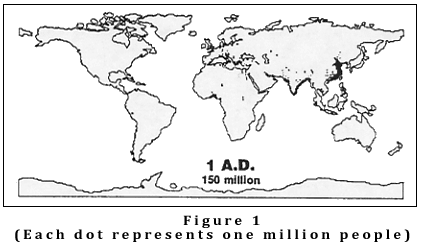
|
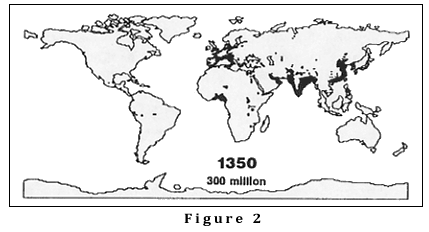
|
I. The 1600s and Pillar One:
Public health measures, pre-modern medicine, and the beginnings of the
population explosion
During the seventeenth century, the foundations were laid for the first of three main pillars that account for the migration dilemmas we face three centuries later. Scientific and medical discoveries led eventually to the first public health practices and, much later, to modern individualized health care. These both ultimately reduced death rates while disturbing high birth rates very little, leading to the unprecedented growth of human numbers we see today.
A quick survey of the medical highlights of the 1600s shows that Barelli4 did pioneering work on human physiology, as did Santario. In 1626, the latter was the first to measure human temperature with a thermometer. In 1619, the Royal College of Physicians in London issued its first pharmacopoeia, presaging today's compilations on drugs. Harvey announced his seminal discovery of the circulation of the blood in the same year. Quinine came into use in the 1640s, as did arsenic. The Dutch physician, Diemerbrock, published a book on the plague in 1649. Books on anatomy and surgery appeared. Willis described typhoid fever in 1659; midwifery forceps followed in 1665; a description of diabetes appeared in 1670. The first medical treatise written in the Americas was published in 1678, discussing smallpox and measles. These were all forerunners of today's public health practices and powerful medical technology.
Perhaps most significantly, in 1674 the Dutchman Leeuwenhoek first saw microbes with a microscope he had invented, paving the way for the germ theory of disease and the discovery of antibiotics. But the story of civilization is not one of uninterrupted progress; in 1697, Daniel Defoe first recommended the adoption of an income tax!
Figure
3 shows the demographic situation at the close of the 1600s the human
population was about 600 million, four times that of our starting point of 150
million.
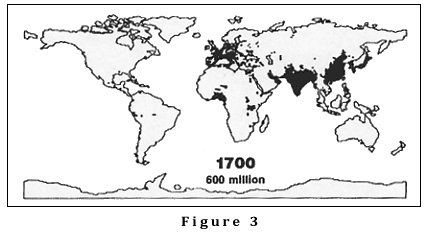
|
II. The 1700s and Pillar Two:
The industrial and transportation revolutions
The 18th century saw the early development of the second pillar on which modern-day migration problems rest the self-reinforcing industrial and transportation revolutions. The central figure in these advances was surely James Watt, with his inventions relating to the steam engine.
Beginning in 1765, the 28-year old Watt invented a condenser to recapture energy from waste steam and thus increase the energy efficiency of steam power. By 1769, he had patented his steam engine. In 1781, he invented the gears that converted the engine's reciprocal motion into the rotary motion of a shaft, highly important for applications to transportation.
In 1782, Watt constructed a more efficient double-acting engine, in which the piston was pushed from both sides. Then in 1784, he came up with what he considered his most ingenious invention, which he called 'parallel motion.' It was a new way for connecting a piston to a shaft. He followed up with his centrifugal governor in 1788, a pressure gauge in 1790, and then a counter, an indicator, and a throttle valve.
While Watt's engine powered the industrial revolution, it also revolutionized transportation. By 1783, d'Abbans had installed a steam engine in a paddle wheel boat. In 1804, Trevithick built the first steam locomotive.
Overseas travel was further aided by Vitus Bering, Captain James Cook, Louis-Antoine Bougainville, and George Vancouver, who explored the globe and made maps. Navigators improved their instruments, allowing more accurate determi-nation of latitude. The British Parliament in 1714 offered a £20,000 prize for the discovery of a method of calculating longitude within 30 miles during a sea voyage. The Englishman, John Harrison, solved this age-old problem and won the prize by inventing a highly accurate and durable chronometer, tested in 1761-62. Lighthouses were built, improving safety on the seas.
The first cast iron bridge was built in 1773, foreshadowing bridging capabilities beyond those allowed by wood and stone. Extensive canal systems were dug in Europe (and started in the American colonies) to transport fuel, food and fiber.
Heralding yet another transport revolution, the Montgolfier brothers flew the first lighter-than-air fire balloon in 1783.
Other industrial changes that I won't detail improved the living conditions of the populace, increasing health and life expectancy, and hence human numbers. The result when combined with better transportation more people who were more mobile.
During the 1700s, the public health and medical fields continued to evolve, addressing chiefly infectious disease. A veterinary school opened in 1761, starting us toward control of animal-borne diseases, such as undulant fever and bovine tuberculosis. In 1776, Jenner introduced small pox vaccination, reducing the death rate. This ancient scourge had killed 10 to 20 percent of those infected —which was nearly everyone, for it is an extremely virulent disease.
Advancing us along the road toward better individual health care, Fahrenheit invented the mercury thermometer in 1714. Aymaud did the first surgery for appendicitis in 1731 (without anesthesia, probably just draining an abscess). Chest percussion (important for detecting tuberculosis) came along in 1761, the same year that Morgagni launched the study of pathological anatomy.
Figure 4 approximates the demographic situation at the close of this second century of major industrial, transportation, public health, and medical advances. Humans now numbered about 900 million —six times the population used as the starting point for this paper.
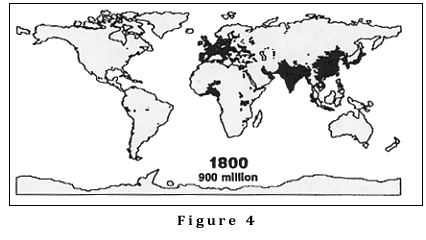
|
III
. The 1800s and Pillar Three:
Better communications
By 1800, two of the three pillars undergirding today's migration problems were well in place and undergoing rapid development. First, public health improvements combined with better living conditions had started to cut the death rate and engender population growth —the principle 'push' factor in human migration. Second, transportation improvements launched in the 1700s and advanced in the 1800s made it possible in the 1900s to move huge numbers of people long distances with greater speed, safety, and ease, at a moderate cost.
The 1800s witnessed the early development of the third pillar that supports today's mass international migration improved communications. This century—the first electrical century—produced a virtual pantheon of electrical greats, like Faraday, Maxwell, Morse, and Marconi, who laid the foundations for the communications revolution.
André Amperé set down the laws of electrical dynamic action in 1820. Faraday described electromagnetic rotation in 1821, discovered electromagnetic induction in 1831, conceptualized electrical and magnetic lines of force in 1832, and in 1834 wrote the Law of Electrolysis (of great importance in chemistry). Ohm formulated his Law of Potential and Resistance in 1827. Wheatstone invented his bridge for electrical measurements in 1833. By 1834, Morse had installed a functioning telegraph between Baltimore and Washington and had developed his Morse code. A printing telegraph appeared in 1856. Lord Kelvin invented the galvanometer in 1858. Maxwell published his famous and fundamental equations in 1865. Edison improved the telegraph in 1872, and Bell invented the telephone in 1876.
But then the limitation of the wire was broken! Hertz reported on the nature of radio waves in 1888, and the 21-year old Marconi announced the invention of the wireless telegraph in 1895; it utilized the Morse code. As the century closed, Fessenden transmitted human speech by radio waves for the first time.
The stage was now set for the inexpensive and nearly instantaneous transmission of information to the most remote corners of the globe, where it could stimulate interest in migration. (Some years ago, herdsmen in East Africa actually held up their annual migration for two weeks so they could watch the last episodes of Dallas!) Improvements in transportation enabled masses of people to migrate, either to fulfill their highest hopes or to escape their worst fears. And migrate they did, by the tens of millions.
Further Medical Advances
These movements will be reviewed shortly, but first let us note the continued evolution of the public health, medical, and transportation fields.
In 1827, Simpson developed sand filters to purify the London water supply, of obvious benefit to the city's public health. Oliver Wendell Holmes, Sr. wrote a paper on puerperal (childbirth) fever in 1843. The obstetrician Semmelweiss discovered the contagious nature of puerperal fever, and as a preventative, advised his fellow physicians in 1874 to simply wash their hands between patients as they attended women in labor. He was driven mad when the medical establishment pilloried him for such radical advice. Pasteur formulated the germ theory of fermentation (1861), invented pasteurization (1864), a chicken cholera vaccine (1880), and a vaccine for the dreaded rabies (1885). After he died in 1895, the Pasteur Institute was established in Paris to perpetuate his work and memory.
One of the most significant public health measures of the century, however, was Englishman Thomas Crapper's invention of the flush toilet, which he demonstrated at the Health Exhibition in London in 1884. This device helped control water-borne diseases, no mean killer of people cholera epidemics around the middle of the nineteenth century killed 30,000 people in London alone.5
Care for individual patients was still ineffectual, but some progress was being made. In 1816, René Laënnec invented the stethoscope —important for diagnosing and treating the ancient (and now recrudescent) scourge of tuberculosis. The British medical journal, The Lancet, first appeared in 1823, fostering the communication of medical ideas. Morton gave the first ether anesthetic in 1846; the first appendectomy (now with anesthesia) followed in 1847.
In 1865, Lord Lister introduced the disinfectant carbolic acid and launched the concept of antiseptic surgery, tolling the end of the era of 'laudable pus' in medicine. In 1871, Hansen discovered the leprosy bacillus.
Robert Koch identified the anthrax bacillus in 1876 and developed a method for staining and identifying bacteria in 1877. In 1882, he discovered the tubercle bacillus, developed an inoculation against anthrax (1883), and in 1887, formulated his seminal 'Four Postulates' for proving the bacterial causation of a disease.6 To round out his career, he traveled to India to discover the causative organism of cholera and while en route, identified the organisms that caused two varieties of Egyptian conjunctivitis (a severe eye inflammation). What a record!
Closing out the medical events of the 19th century the malarial parasite was discovered in 1890, the plague bacillus in 1894, and the dysentery bacillus in 1898. Steam sterilization of surgical instruments started in 1886, rubber gloves were introduced in 1890, and Roentgen discovered X-rays in 1895. The translation of these advances into definitive, personal and life-saving systems of patient care was to come in the next century.
As a result of public health measures and better living conditions fostered by the industrial revolution, death rates decreased, especially among the young. Children who formerly would have died survived to reproduce themselves, and human numbers expanded. By 1850, population approached 1.2 billion—approximately eight times our starting population of 150 million in 1 A.D.
Further Transportation Advances
Industrialization and transportation also evolved rapidly in the 1800s. Fulton built a steam-powered paddle boat in 1803. Bell had a steamship running on the Clyde in Scotland by 1812. Fresnel invented his prisms in 1822, greatly improving the efficiency of lighthouses and safety on the high seas. The first steamship crossed the Atlantic in 1827, reducing travel times by days and eventually weeks. A steam-powered, screw propeller ship first appeared in 1829, and could do 6 knots! In 1872, Lord Kelvin invented a machine that allowed ships to take accurate depth soundings at sea—another major advance in safety.
On the rail front, George Stephenson built the first practical locomotive in 1814. Trains first carried passengers in Britain in 1825, and in the United States in 1828. The first Swiss railroad opened in 1847, and three years later Robert Stephenson (George's son) constructed the first cast iron bridge capable of carrying a train. Rail lines were pushed through the Brenner Pass by 1867 and construction of the trans-Siberian railroad was begun in 1891 (and completed in 1917).
Transportation by car was not far behind. Macadam developed a road building process that still bears his name. An internal combustion engine was developed in 1860. Benz built the first single-cylinder motor car engine in 1885, and followed up in 1893 with the first four-wheel car. Ford's first 'flivver' appeared in 1894.
Advancing the concept of air travel, Count Zeppelin constructed his lighter-than-air ship in 1895.
We would be remiss if we failed to note the highly significant agricultural revolution that took place alongside the industrial one. New crops from the New World rounded out and enhanced the diet potatoes in the north of Europe, tomatoes and maize (corn) in the south.7 Cultivation of sugar beets started after the British blockaded ports and supplies of cane sugar during the Napoleonic wars.
Patent and Copyright Laws
Let us pause here to note the creation of two key social conventions that bridged these three centuries and facilitated much of this: scientific innovation patent and copyright laws.
An early patent law, the statute on monopolies, was adopted in England in 1623. As one of its first acts, the United States Congress passed a comprehensive patent statute in 1790. So did France in 1791, as did numerous other countries in the 1800s. The International Convention for the Protection of Industrial Property was signed in Paris in 1883, initially by 11 countries.
The first copyright act, the Statute of Anne, passed in England in 1710. Denmark followed suit in 1741, the United States in 1790, and France in 1793. The Bern Convention, an international copyright accord, took effect in 1886 with 14 signatories.
These social measures served the twin goals of financially protecting those who made scientific advances while assuring that the innovations were disclosed and eventually became public property. They were of more importance in the transportation and communications fields than in medicine, where a different ethic of freely sharing discoveries (at least among physicians) was and still remains in place.
The Situation at the Close of the 19th Century
Having reviewed the three main lines of discovery and invention both caused and enabled the mass migrations of the 1800s and 1900s, let us pause to sum up mankind's situation after three centuries of continuous scientific advancements. Figure 5 approximates the demographic situation in 1900, with a world population of about 1.6 billion, about ten times our starting point of 150 million.
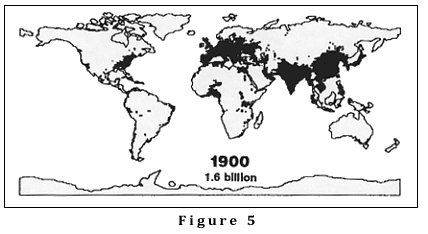
|
The Reverend Thomas Robert Malthus published On the Principle of Population in 1798. It was no accident that his seminal essay appeared then. By the end of the 1700s, Europe's population had grown to the point where, given the then-available technology, it pressed hard upon its resource base. The Europeans were worried about supporting their increasing numbers.
As a practical matter, the space and resources of the Americas were not yet available to the Old World. It took months to cross the ocean in tiny ships—with frequent dismastings, sea sickness, and shipwreck in the bargain. The oft-cited (but little read and less-understood) Malthus observed that while humans had great reproductive powers and often had many children, the human population increased much more slowly than high birth rates would seem to predict. In his view, numbers were held in check by 'misery and vice,' that is, the classic Four Horsemen of the Apocalypse war, civil strife, hunger, and death. Shortages of food, clothing and shelter, coupled with diseases, killed many people or kept them from marrying and reproducing. Malthus's chief concern was with food supplies, and the slow rate at which they could be increased.
Then the unexpected happened. Thanks to improvements in transportation, the New World became more accessible. Surplus people poured out of Europe (perhaps 50-60 million between 1840 and 1930). Resources were imported by the Old World to supply its industries, and overseas markets opened up for the resulting manufactured goods.
As railroads reached the American midwest, they were able to carry grain to Atlantic seaports where it could be shipped inexpensively to Europe. The flood of cheap imported food closed down farms all across England, Europe, and into Russia.8
Traveling east, ships were heavily laden with bulky raw materials; returning west, they were lightly loaded with more compact manufactured goods. Rather than carry ballast on the westward leg, the steamship companies decided instead to haul paying passengers. (The streets of Boston in the earlier years had been paved in part with stones from Europe—non-paying ballast stones!) To that end, agents were sent to the interior of Europe to promote emigration, at which they proved very effective. The displaced farmers and others embarked on boats returning to America, where they took up farming and perpetuated the cycle of dislocation. My maternal great-grandfather was typical. Migrating at age 27 after discharge in 1854 from one of the many German armies, he was eventually naturalized at Niagara Falls, New York in 1868. He became a farmer, as are many of his descendants to this day.
Europe's incessant wars, and such catastrophes as the potato blight of the 1840s and '50s (which also occurred on the Continent though with less severe consequences than in Ireland)9 drove others to leave.
The net result of the opening up of the New World was that Malthus's cup of 'misery and vice' was taken away for a while. Europeans pushed by straightened circumstances at home and pulled by the opportunities of the New World, proceeded to colonize the newly opened lands and utilize their resources. I specify Europeans because this migration was largely a Europe-to-New World phenomenon, and was based on the European scientific advances outlined in this paper.
By contrast, in Africa (except for the slave trade), on the Indian subcontinent, and in Asia, population growth remained largely in situ. (It was also much less, due to the absence of most of the factors we've cited that engendered European population growth and migration.) Only the Europeans were in a position to export their excess popu-lation, and use these expatriates to harvest and ship back home overseas resources. The colonists in turn provided a market for manufactured goods, further spurring the Industrial Revolution. Indeed, demographer Kingsley Davis calculates that had Europe not been able to export its surplus people, its population in 1970 would have been 50 percent larger than it was—1.08 billion rather than 650 million.10
Davis also notes that until the great trans-Atlantic migration of 1840-1930, the historic direction of migration had generally been from sparsely settled territories to thickly settled ones, and from less-advanced to more-advanced areas, i.e., from the rural to the urban. Then the direction of the flow reversed, with people leaving thickly settled and developed Europe for the sparsely populated and rugged overseas frontiers. Today, he notes, the historic pattern has returned, with flows now running toward the developed countries, though in some cases the donor countries are more thickly settled than the recipient ones.11
The 20th Century: Raising the Stakes
We now arrive at our own century, the population dynamics and scientific developments of which are well enough known that they need not be reported in detail. Suffice it to state that in the transportation and communication fields, innovation and advancement have gone apace, stimulating interest in and facilitating migration.
Medicine, however, has changed. While public health measures have continued to appear (vaccines for diphtheria, whooping cough, tetanus, polio), the age of potent, life-extending, individualized health care is upon us. This is now an increasingly important factor in the expansion of human numbers.
In addition, our scientists have given us pesticides to suppress plant and animal diseases, and fertilizers, herbicides, and the green revolution to produce more food. We Homo sapiens have responded by increasing our numbers to match and test these new limits. Here is a summary of our situation at century's end.
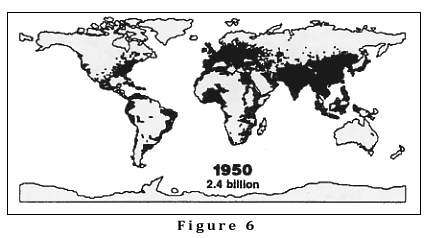
|
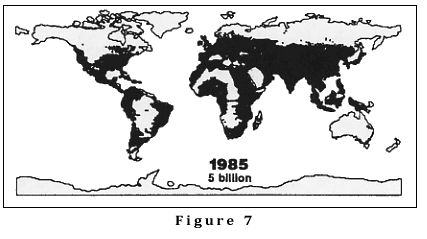
|
Population Push Pressures
World population by 1950 had reached about 2.4 billion, sixteen times our base-year number of 150 million. By 1985 - just 35 years later - it had doubled to approximately 5 billion. (Figures 6 and 7.) As of the 1990s, the percentage rate of population growth may be down somewhat, but it now applies to a progressively larger base, so that today the net increase (births minus deaths) is 10,000 per hour, 250,000 per day, 90-plus million per year - the fastest numeric increase in world history. When India lost 30,000 people in an earthquake in 1993, it replaced that number by itself in just two eight-hour shifts; its population currently grows by 50,000 per day.
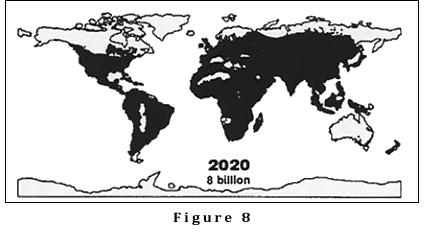
|
Making matters worse, demographic momentum now at work (and beyond reversal in the short term) will greatly swell world population over the next few decades, inevitably increasing human misery and therefore migration push pressures. (Figure 8.)
In the U.S. by 1990, our population had grown to 250 million, nearly sixty-four times the 4 million counted in the first census in 1790. The Census Bureau now projects that by 2050, our population will reach 392 million—a further 60 percent increase—due chiefly to admission of large numbers of young and fertile immigrants.12
Beyond
just human numbers, consider:
Employment Push Pressures
In March of 1994, the International Labor Organization reported that per capita income for the world's workers fell in 1993 for the fourth straight year. Thirty percent of the world's labor force—820 million people—were unemployed or under-employed at the beginning of 1994.13
Basing
our prediction on the number of people already born (this is not a
'guesstimate'), we can see that between 1990 and 2010 the work force of the
less-developed countries will expand another 800 million, far more than the
entire current work force of the
more-developed countries (less than 500 million). Where will these people find
work?
Social and Political Push Pressures
Freedom House, which reports annually on the status of freedom around the globe, states that as of 1993, only 19 percent of the world's population lives under conditions it describes as 'free.' Those living under 'partially free' conditions make up 40 percent; the 'not-free' account for 41 percent. Adding these last two figures together, we find that over 80 percent of the world's 5.4 billion people - some 4 billion souls - live under conditions less than 'free.' Most of these people could improve their lot in several ways by moving to a developed country. This reservoir of human discontent grows by about 80 million per year, as 90 percent of the world's annual population growth of 90 million occurs in less-developed and less-free countries.
Environmental and Natural Disaster Push Pressures
A nearly endless list could be cited deforestation-exacerbated floods in Bangladesh;14 the collapse of fisheries in the Black and Azov Seas resulting from the accidental introduction of the West Atlantic comb jelly fish;15 pollution in the former USSR;16 the desertification of Africa's Sub-Sahara; and so on.
Natural disasters such as earthquakes, volcanic eruptions, and floods now find many more people 'in harm's way.' Many of the people displaced by such acts of God are candidates for moving to higher and firmer ground.
But to Where Can Such Populations Move?
North America cannot accommodate huge additional numbers—it is now quite fully occupied, with scarcely any virgin land or untapped resources awaiting settlers. Easily accessible resources have been substantially harnessed and, in many cases, run down. South America still has sparsely populated areas, but is hardly in a position to resettle tens of millions of people with the attendant economic costs and social turmoil.
Europe is more densely populated than North America, and an even less likely candidate for resettling millions of migrants. For instance, reunited Germany has a surface area about equal to that of the combined states of Oregon and Washington; but it has a population one-third that of the entire United States. The Netherlands is twice as densely populated as Germany, with an average 1,300 people per square mile. How can either of these places receive millions of newcomers? The same is true of most of Europe and the habitable portions of Africa and Asia. The globe's hospitable lands are in the main already taken up.
Does outer space offer an answer? Regrettably not, at least in our time. We know of no other liveable planets. Even if we did, just to keep up with population growth, we would need to fire 10,000 people an hour into space - never to return. Anything less would be demographically ineffective. Any volunteers?
In Addition: Growing Resistance to Migrants
From the pool of 4 billion potential migrants, there are probably fewer than four million persons worldwide who are allowed to migrate legally each year—about one in 1,000, or 0.1 percent. (Table 1.) Of the 170-plus member countries of the United Nations, only a handful still seek immigrants. And in each of these countries, public opinion polls show strong opposition to both illegal and legal immigration. Serious reexamination of immigration policy is under way in all of these countries with sharp reductions as a possible outcome. The other U.N. members are in the market for newcomers only under the most stringent of conditions, and usually in very limited numbers.
In retrospect, it took only 200 years—1790 to 1990—to skim the cream of the Americas' resources and return mankind to the conditions faced in Europe in 1798 when Malthus wrote his essay millions of people in dire circumstances, with huge pools of under- or unemployed labor. But now the numbers are vastly larger, and no virgin continents await settlers.
|
Table 1 Legal Immigration to the Main Immigrant-Receiving Nations
*This includes 281,847 ethnic Germans from the former East Germany, Eastern Europe and Russia. **Italy doesn't consider itself a country of immigration and so does not keep relevant data. The 11,350 are family reunification visas and asylees (2,650), but do not include tens of thousands of people of Italian descent returning from places such as Argentina. ***This includes 880,372 aliens granted permanent residence under the provisions of the 1986 Immigration Reform and Control Act. SOURCES: Center for Migration Studies (Washington, DC); European Forum for Migration Studies (Bamberg, Germany). |
End of the Migration Epoch?
It is hard to envision a win/win outcome to our migration dilemma. In sum, as the second millennium closes we find the 'irresistible force' of growing migration pressure confronting the 'immovable object' of escalating resistance to migration.
How Will It All Turn Out?
If the developed countries cannot or will not control their borders, they will quickly be swamped in the remaining years of this century or the opening ones of the next. It seems unlikely that their welfare systems can provide benefits to any and all who can afford the price of a ticket, or that their social, political, and economic systems can cope with the resultant plethora of languages, religions, races, and ethnicities. Even if the developed countries take in tens of millions, it will have little effect on the growing numbers of people left behind. In this hapless scenario, migration would stop only when it is no longer worth moving - only when abject poverty prevails everywhere. I cannot believe the developed countries would allow this to happen.
If the developed countries do muster the will and the very considerable resources required to con-trol their borders, we will be the subject of 'Isle-of-Prosperity-in-a-Sea-of-Misery' TV shows - shows that vividly portray the chaos and anarchy that many envision for the Third World.17 Given that many of the developed countries' resources come from the less-developed regions (the U.S. for instance, imports more than 50 percent of its oil) the developed world's future is far from assured in this scenario.
In contrast, let us assume some outpouring of compassion. Say 8 million legal migrants were accepted worldwide in one year, twice the present annual number. That would accommodate only one months' world population increase, and do nothing to decrease the ranks of the discontented. What happens the next year? Do we accept another 8 million, while falling further behind?
My estimate is that as these alternate futures become known, the forces working world-wide to secure borders and decrease immigration will prevail. By the turn of the century, both illegal and legal migration will be severely curtailed. Trans-border migration of impoverished tens of millions, as occurred between 1840-1930, is simply impossible to envision; this would be viewed everywhere as an invasion. It is now and would then be vigorously resisted by whatever means necessary.
Toward a New Paradigm
I have picked my words carefully. I write of the virtual end of migration of people who will be welcome, wherever in the world they may settle. Doubtless, some clandestine migration will continue, but most migrants will increasingly be resented by the majority of the populace in the target countries.
The world is not full, but is fully occupied, and by those who for reasons lamented by some and lauded by others, do not wish to divide their patrimony into smaller pieces by admitting more people. Unfortunately, we can offer no encore analogous to the occupation in the 1800s and 1900s of the Americas and Australia/New Zealand. There are no new continental land masses to be discovered, and few remaining unclaimed virgin resources. We have finally done it—we have spread completely across the habitable surfaces of the globe, and fulfilled at least one Biblical injunction—to be fruitful, multiply, and subdue the earth.
The three scientific revolutions that made migration a solution in the fin de siècle times of the 1890s have now made it a difficult problem in the fin de millénaire times of the 1990s. To review
1. Medical and public health science are relentlessly saving lives and, by postponing death beyond the fertile years, pushing human populations to ever higher levels.
2. Communication technology is constantly evolving and ever cheaper, informing people of bad conditions at home and greener grass elsewhere.
3. Transportation improvements are making it ever more possible for huge numbers of people to move at relatively small expense anywhere on the globe in a matter of hours.
I predict that future historians, looking back on the end of the second millennium, will report that just as mankind went through Ages characterized as Stone, Bronze, and Iron, so it went through an Immigration Epoch that bridged all of those ages, and came to a close about the year 2000. Movement of people continued just as did use of stone, bronze, and iron, but the human race had to find ways other than migration to address its problems. There was no alternative.
An important chapter in human history had closed.
Needed: A Paradigm Shift
The world has changed since our Republic was formed 200 years ago. Our mental image of it must change to keep pace. Thomas Kuhn calls such readjustments 'paradigm shifts' and defined them in his 1962 book, The Structure of Scientific Revolutions, as 'a set of assumptions about reality—an accepted model or pattern that explains the world better than any other set of assumptions.'18
The next section lays out side-by-side some of the paradigm shifts needed to align our view of international migration with new realities.
A Proposed Shift in the Immigration Paradigm
|
The Old Dogma |
The New Understanding
|
|
1. There is enough for all, regardless of numbers. Selfishness and greed are the problem. Just distribution is the solution. |
1. Resources and livable conditions are scarce. Manna does not fall from heaven. Scarcity is the rule, and requires a degree of self interest.
|
|
2. The population problems and pressures can be solved by moving people to sparsely populated countries. |
2. Population problems are beyond solution by migration. No habitable, unclaimed lands remain. Most people will never be able to leave the country of their birth.
|
|
3. Large scale migration can continue indefinitely. |
3. The large scale migration of the last 200 years is an aberration enabled by conditions that cannot be replicated. In a limited world, it must necessarily come to an end.
|
|
4. National boundaries are arbitrary and illegitimate. We should transfer our allegiance upward to world government. Robert Frost was right 'Something there is that doesn't love a wall.' |
4. The nation-state is one of the essential levels of human government. Modern life is impossible without it; most people will transfer their loyalties down to the clan or tribe, not upward to world government. Robert Frost's neighbor had it right 'Good fences make good neighbors.'
|
|
5. We are a nation of immigrants. The Statue of Liberty stands for open immigration. |
5. All nations are nations of immigrants at some point in their history. The United States is not special in this regard. The Statue of Liberty stands not for immigration but for the rule of law and 'Liberty Enlightening the World.'
|
|
6. Immigration is primarily a civil liberties problem to be dealt with by specialists lawyers, judiciary committees, courts. |
6. Immigration is primarily a population and resource problem. Policy should be set by demographers, resource committees and biologists, in consultation with the citizenry.
|
|
7. The proper focus of our attention is on those who migrate - the less than 0.1 percent. |
7. The proper focus is on the 99.9 percent of people who remain at home to contend with the conditions that migrants leave behind. They are the ones who most need and deserve our support.
|
|
8. Those who migrate are to be celebrated as heroes. |
8. Those who stay and struggle to change things for the better - the Lech Walesas of the world - are the real heroes. |
|
9. Limiting immigration is selfish or worse. |
9. Limiting immigration and hence population growth is our duty if we are to pass our national estate on to our successors in livable condition. Migrants are usually selfish in their motivation.
|
|
10. Diversity is good and more diversity is better - without limit. |
10. Commonality is also good and essential to workable social arrangements. Too much diversity leads to divisiveness and conflict. |
But what about ethics and morals? What is the right thing to do?
Many great human questions are at bottom ethical and moral, rather than economic or political. Elimination of the age-old practice of slavery was not based on cost/benefit analysis. Philosophers and their governments have long sought to define the 'just' war. Volunteer associations by the hundreds are actuated by high-minded concepts of right and wrong, even in this secular era.
Down through the years, many codes of conduct have appeared to guide mankind in wrestling with ethical or moral decisions. Without such common, agreed-to benchmarks, resolution of disputes and probably even civilized life would not be possible.
Control of migration is one of the great and age-old human questions. Based on the new paradigm presented above, we need to develop a new set of principles to guide the formulation of immigration policy. These are the ones that seem to be evolvin:
A New Decalogue For An Increasingly Crowded World
Principle I: World population growth of 10,000 per hour, 250,000 per day, 90-plus million per year, dwarfs the absorptive capacity of the few countries still willing to receive legal (and certainly illegal) immigrants. The stresses caused by population growth cannot be solved by international migration. They must be confronted by and within each individual nation.
Principle II: The nation-state, remains an essential unit of human governance. Sovereignty is the guarantee of a nation's and its citizens' right to exist. Sovereignty includes the right to regulate entry into one's territory. The United Nations' Universal Declaration of Human Rights19 recognizes this by enumerating a right of emigration, but not of immigration. The alternative to delineating and controlling borders is anarchy.
Principle III: Each nation has a solemn responsibility to provide for the health, education, employment, and security of its own citizens. No nation can expect to solve deficiencies in these areas by exporting its surplus people. Fundamental to the concept of national rights and responsibilities is the duty of each nation to match its population with its political, social, and environmental resources, in both the short and the long term. No nation should exceed what the biologists call its 'carrying capacity.'
Principle IV: In setting its immigration policy, any nation must first look after the interests of its own citizens, including those at the bottom of the socio-economic ladder. The long term consequences of any actions, including the need to ensure social cohesion, and the long range management of social, political, and environmental resources must be considered. Passing these on in healthy condition to future generations must be a fundamental objective of public policy. This is not selfish; it is a requirement of social responsibility.
Principle V: Each nation should train its own technical and professional personnel, matching supply to demand. The developed countries in particular should not continue to encourage a brain drain from the less-developed countries, luring their talented people, and thus benefitting from the scarce capital that went into their education. On their part, the less-developed countries should educate their citizens in fields appropriate to their own country's needs, and not for some personnel export market.
Principle VI: Each nation should arrange to do its own drudgery work, even if this means extra expense to improve the wages and conditions of service workers. Communities within the developed countries that have few or no immigrants have long demonstrated their ability to maintain themselves without outside help. In the long course of human history, there have always been those who wanted to harvest the product of another's labor. This was the underlying theme of slavery. It is time we closed this chapter of human history.
Principle VII: Illegal immigration is unacceptable, both for the individual migrant and for the recipient nation. Newcomers should arrive legally, indicating their respect for the laws and customs of their prospective new land. If workers have legal status, it will reduce the temptation of potential employers and others to exploit newcomers because of their illegal status. Illegal immigration should be held to the irreducible minimum.
Principle VIII: Legal immigration should come under the discipline of a 'budget' concept, one that specifies an all-inclusive ceiling. If more in one category are to be admitted, balancing cuts must be made elsewhere.
The three fundamental questions that must be answered to set a policy on legal immigration are:
1. How many people shall we admit, and what factors should be taken into account in setting this limit?
2. Who should be chosen to immigrate, and what criteria should be used for choosing among candidates?
3. How can we humanely enforce the rules we decide upon?
To be taken seriously, any proposed legal immigration policy must set out specific answers to this 'How-Who-How' trilogy.
To underscore the value of citizenship, legal immigrants should enjoy a lesser 'bundle of rights' than citizens during their trial period of legal resident alien status. When they become eligible for naturalization, they should either commit themselves fully to their new country by becoming citizens and receiving full rights and accepting full responsibilities—or, if they choose not to make this commitment, should return home, making room for someone else. Both dual citizenship and permanent, lifelong resident alien status are ethically unacceptable. People should commit themselves to one polity or another, and participate fully in efforts to improve its social, political and economic life.
Principle IX: Concerning asylees and refugees, the emphasis should be on temporary succor with eventual repatriation, rather than permanent settlement. The UN High Commissioner for Refugees states that repatriation must be the solution for most refugee problems, given the numbers involved.20 The limited refugee funds available are better spent on the relatively inexpensive per capita maintenance of many refugees in their region of origin, rather than on expensive permanent resettlement of a few in the developed countries. Refugees should not be introduced to the developed countries if there is to be any hope of repatriation.
Principle X: The epoch of international migration as a solution to human problems is over for the overwhelming majority of mankind. Most people will never be able to move from their place of birth; there are simply too many people and too few places left to go. Instead, individuals will have to work to change conditions they find unacceptable.
Acknowledgement of the realities underlying these principles could usher in a whole new epoch in human history, one in which support will flow toward individuals attempting to deal with their problems, rather than to those who simply take flight from them.
The astute reader will note that we have not placed heavy emphasis on a plethora of 'immigrants' rights.' Rather, we emphasize the rights (and responsibilities) of the citizens in both the receiving and sending countries.
Many axioms and corollaries to this basic set of ten principles could and need to be enunciated. However, these broad guidelines can provide an overall framework for policy making.
In Summary: End of the Migration Epoch!
It is now time to remove the question mark from the title of this essay and replace it with an exclamation point to assert that the convergence of events and data show that we are fast approaching the end of the Migration Epoch. Welcoming international migration—legal, and especially illegal—is no longer a practical option for almost all of the world's people. Rather, they will have to bloom where they are planted if they are to bloom at all. They will have to work to change conditions they don't like rather than just move away from them. Helping make it possible for them to stay rather than leave is the proper focus for our efforts.
Rampant twentieth-century population growth has brought sobering new realities. We must adjust our immigration paradigm and its derivative ethical system accordingly.
NOTES
1 In pursuit of his demographic and immigration policy interests, Tanton has served as organizer and president of Northern Michigan Planned Parenthood (1965-71); as chair of the national Sierra Club Population Committee (1971-74); as a member of the national Zero Population Growth board (1973-78); as chair of its Immigration Study Committee (1973-75); as its national president (1975-77); as organizer (1979) of the Federation for American Immigration Reform (FAIR) and its chair (1979-87); and as a board member of Population/Environment Balance (1980-90).
2 For an excellent overview of these early human movements, see Kingsley Davis, 'The Migration of Human Populations,' Scientific American, Vol. 231, No. 3, September 1974, pp. 93-105. In my view, this article is one of the classics in immigration literature.
3 The main resource used to construct these population growth maps was The Atlas of World Population History by C. McEvedy and R. Jones (New York Penguin Books, 1978) plus data published by the Population Reference Bureau, Inc., 1875 Connecticut Avenue, N.W., #520, Washington, D.C. 20009, 202-483-1100.
4 The dates for the historical events mentioned throughout this paper are taken from The Timetables of History by Bernard Grun (New York Touchstone Books/Simon & Schuster, 1982). This book was originally published in German as Werner Stein's Kulturfahrplan - an excellent addition to the library of anyone with an interest in history.
5 William Ecenbarger, 'Flushed with success,' Chicago Tribune Magazine (April 4, 1993), pp. 23 ff.
6 Koch's Postulates
1. Obtain an organism from a diseased individual.
2. Grow it in pure culture.
3. Inoculate a healthy individual with the organism and precipitate the original disease.
4. Successfully reculture the same organism from this newly infected individual.
Koch held that this sequence proved that the organism was the cause of the disease.
7 William McNeill in Seeds of Change A Quincentennial, Herman Viola and Carolyn Margolis (eds.) (Washington, D.C. Smithsonian Institution, 1991).
8 Daniel P. Moynihan, Pandaemonium: Ethnicity in International Politics (New York Oxford University, 1993), pp. 137-138.
9 Cecil Woodham-Smith, The Great Hunger (New York Harper & Row, 1962); McNeill, op. cit.
10 Davis, op. cit, p. 99.
11 Davis, op. cit., p. 95, 100, 102.
12 Gary Blonston, 'Census Forecast for 2050 Gives Minorities Big Gains,' Detroit Free Press, December 4, 1992, p. 3A.
13 David R. Sands, '1 in 3 Worldwide Can't Find a Job or Living Wage,' The Washington Times, March 7, 1994.
14 Thomas F. Homer-Dixon, Jeffrey H. Boutwell and George W. Rathjens, 'Environmental Change and Violent Conflict,' Scientific American (February 1993), pp. 38-45.
15 John Travis, 'Invader Threatens Black, Azov Seas,' Science, Vol. 262, November 26, 1993, pp. 1366-1367.
16 Jon Thompson, 'East Europe's Dark Dawn; The Iron Curtain Rises to Reveal a Land Tarnished by Pollution,' National Geographic, June 1991, pp. 36-69.
17 Robert D. Kaplan, 'The Coming Anarchy,' The Atlantic Monthly (February 1994), pp. 44-76; Jean Raspail, The Camp of the Saints (New York Charles Scribner's Sons, 1975); Homer-Dixon, op. cit.
18 David Osborne, 'The Power of Outdated Ideas,' Chicago Tribune, January 12, 1992, p. 13.
19 Universal Declaration of Human Rights, December 10, 1948, Article 13, No. (2).
20 See in general 'The State of World Population 1993,' United Nations Fund for Family Planning.
This article can also be found in the Social Contract website archives, Volume 4, Number 3 (Spring 1994).
Editorial Note: John invited the response of six people likely to object to this thesis. Their comments and his responses can be found on The Social Contract website at www.TheSocialContract.com in the Archives Section, Volume V, No. 1, The above article is in Vol. IV, No. 3. A reprint of this material is available from The Social Contract Bookstore, located on the website.
